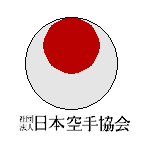| |
"The Interaction of Physiology and
Character in the Martial Arts"
September 10, 2003
By Shojiro Koyama
With Lana Susskind-Wilder
Many karate schools advertise that they teach
"martial arts", but unfortunately, often do not specifically define what
is meant by that term. The school may, on the surface seem to provide
training in martial arts, but in fact may focus so heavily on tournament
competition and sports style karate that it loses the connection to the
principles that underlie its roots. Such principles may be codified in
standards such as the dojo kun, however they are difficult to monitor
and enforce at the level of the individual dojo, especially when they
are parroted by rote, misunderstood by the students and not adhered to
by the instructors. At some of these dojos, what is advertised as
martial arts may turn out to be more along the lines of sports
competition at best, and street brawling at worst! Students may be
subtly or even overtly discouraged from moderating their
testosterone-induced aggressive instincts in order to bolster their
tournament performance and likelihood of victory in the ring
Sumo wrestling is a traditional Japanese martial art in which aggressive
competition is very important. However, sumo differs from a pure sports
activity and illustrates a fundamental characteristic of martial arts in
that while victory is important, it is not everything. To be a sumo
Grand Champion, one must not only win in tournament, but must also
display a commitment to perfection of character at all times. The
deportment of a true sumo Grand Champion reflects dignity, integrity and
honor. Because sumo champions are important celebrities in Japan, they
are highly visible, and must therefore be willing to recognize and
accept their obligation to display integrity and honor in all of their
public behavior, in the ring and out. Therefore, non-sportsman-like
displays of emotion on the tournament floor, whether one wins or loses,
are inappropriate and unacceptable for a competitive Japanese sumo
wrestler. It is very interesting to watch a sumo match. Even though it
is physiologically unnatural to suppress the intense emotions that
accompany aggressive competition, the contestants almost never engage in
passionate displays. Consider how different these sumo wrestlers behave
than do, for example, many professional football players after scoring a
winning touchdown. This type of moderation is also traditional among
practitioners of other true Japanese martial arts such as aikido, judo,
kendo, and of course, karate. Students of these activities who do not
behave in accordance with principles of modesty, dignity and honor
cannot truly be considered martial artists in the traditional Japanese
sense. Unfortunately, it seems to increasingly be the case that modern
society is so influenced by the entertainment-sports mentality that many
students of karate behave more like professional football players than
like dignified sumo Grand Champions.
Nobel prize winning biologist Roger Sperry stated that all human
behavior is the result of hormones acting on the nervous system. In
human beings (as well as in animals) passionate physical and emotional
displays are a natural reaction to the secretion of hormones such as
adrenalin and testosterone that accompanies aggressive physical
competition. The body does not know the difference between attack by an
enemy and a controlled kumite match in the ring. In both cases the brain
perceives a threat and reacts by engaging the sympathetic
("fight-or-flight") nervous system and directing the release of hormones
that enable the body to better react to that "threat", whether or not it
is actually real. Such physiological reactions are adaptive when one
faces a truly dangerous situation, however, they can lead to unhealthy
physical and emotional stress when they are too frequent or too intense.
The restraint and self-control displayed by practitioners of martial
arts such as sumo helps moderate what would otherwise be unhealthy
effects of an overabundance of stress and aggression hormones.
Physiologically, this behavior helps counterbalance the arousal caused
by the sympathetic nervous system by engaging the calming effects of the
parasympathetic system. In contrast to the sympathetic system, the
parasympathetic system decreases the heart rate and blood pressure and
deactivates hormones like cortisol and adrenalin that can cause
unhealthy levels of stress, and eventually illnesses such as heart
disease, stroke and even cancer. In this regard, the restraint displayed
by martial arts practitioners that may seem to be merely a means to
spiritual growth and character development is actually physiologically
protective as well.
The two-minute, single point matches of karate are very compatible with
moderation of physical and emotional overreaction. The emphasis on
control, spatial perception and cool-down between bouts of punching and
kicking engage parasympathetic-like elements of the nervous system. This
balance of increase and decrease in physiological arousal is one of the
characteristics that helps to differentiate martial arts from
competitive sports. Unlike martial arts, many sports can be thought of
as promoting only the arousal-supportive functions of the human nervous
system including secretion of testosterone and adrenalin. After the
sports competition is over, the athlete goes home still keyed up and
physically aroused. In the case of the martial arts, during the match
itself the sympathetic nervous and hormone systems are fully engaged,
just like in competitive sports. However, martial artists learn to
moderate these reactions as soon as the match is over, thereby engaging
the parasympathetic system, cooling down more rapidly and controlling
the effects of hormones such as testosterone. We have learned that an
inability to control these effects can be disastrous. For example,
research shows that many criminals have an overabundance of testosterone
and are more likely to react aggressively to its presence.
Long ago, in hunter-gatherer societies, the effects of testosterone on
young males was critical for survival. Male hunters had to have the
strength and aggressiveness to stalk and kill their prey as well as to
effectively protect themselves against wild animals. Women were less
dependent on physical strength and stamina, and in fact, hormones that
increased aggressiveness in female caretakers might have been
counterproductive. The same was true for the older males of the
community who retired from hunting and stayed behind to help raise the
children and became repositories of wisdom. Therefore, as men aged,
nature assisted them in the transition from aggressive hunter to village
elder by decreasing the secretion of hormones such as testosterone.
Human physiology has not changed significantly since the days of the
hunter-gatherers, although society most definitely has. Today, there are
very few functions or activities that are not open to women, including
the more aggressive sports. As a result, balance and moderation are more
critical than ever. Too much emphasis on activities that rely on
testosterone can ultimately complicate human relations and lead to
hostility and violence. Also, it often results in a tendency to devalue
those who are less aggressive and physically strong, either because of
their basic constitutions or the natural, inescapable effects of aging.
As we age, our hormone balance changes and our physical resilience
decreases. We must all learn to adapt to these changes, and to find
value in the spiritual development, wisdom and grace that accompany
aging, lest we become discouraged by the fact that we are no longer
valued for our physical prowess. Remember, hunters, sumo wrestlers and
champion karateka must all eventually face retirement. If we think of
karate as a lifetime exercise, we are able to find new meaning in the
practice of our art, different from but no less important than our
youthful value as tournament competitors and potential champions. |
|



